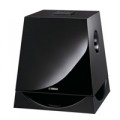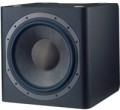Type
— Active. Subwoofer with its own built-in amplifier. This allows you to connect the device to the signal source directly, without any additional external amplifiers. If the connection is made through a common speaker amplifier, the
active subwoofer reduces the load on it, which has a positive effect on the volume and sound quality of the entire speaker. The built-in subwoofer amplifier itself is selected in such a way as to optimally match the characteristics of the speakers used. In addition, active subwoofers often come with their own fine-tuning tools that allow you to achieve optimal sound in your room without moving the subwoofer itself. The disadvantages of an active subwoofer are the need for a separate power connection and the high price.
— Passive. Subwoofer without its own built-in amplifier. Such a device requires connection to the signal source through an external amplifier, the characteristics of which should optimally match the characteristics of the subwoofer (see Power, Impedance). The advantage of
passive subwoofers is their low cost.
Acoustic design
—
Closed type. The simplest type of construction: a closed (sometimes hermetically sealed) case with a speaker placed on the front panel. It is believed that such subwoofers have low sensitivity, which, however, is offset by high sound transmission accuracy and low distortion.
—
Phase inverter type. In the cases of such subwoofers, a tube is installed that has an outlet to the surrounding space. The length of the tube is chosen so that a signal comes out of it, inverted in phase relative to the signal from the front of the cone (in other words, from the main speaker). This improves the sound of the subwoofer and enhances the sound pressure. The disadvantage of a phase inverter is the additional noise from the sound stream in the tube.
—
With a passive radiator. A design similar to a phase inverter (see above) in terms of purpose and principle of operation, however, instead of a tube, such subwoofers use the so-called passive emitter. In fact, it is an ordinary speaker, devoid of a coil and a magnet and playing the same role as the phase inverter tube. The use of a passive radiator allows you to get rid of the noise of the air flow, characteristic of phase inverters.
Phase inverter location
—
Behind. It is recommended to install subwoofers with a rear bass reflex so that the back of the case, where the bass reflex is located, is away from the wall. If you put such a subwoofer right next to the wall, then the sound quality will be noticeably reduced. Bass reflex subwoofers on the back of the cabinet are usually placed in the centre of the room. If it is not possible to put acoustics in the centre, then they try to place this type of subwoofers away from the wall that the bass reflex is looking at.
—
Front. Front-facing bass reflex subwoofers are good if the acoustics need to deeply reveal the image of low-frequency sound. Acoustics of this type are recommended for music in which there is a lot of bass. The front location of the phase inverter allows you to put the subwoofer almost close to the wall.
—
From below. Bass reflex subwoofers are designed to be hung at a height. In this case, there will be no interference in the path of low-frequency sound, that is, the bass will be revealed as fully as possible. If it is not possible to hang such a subwoofer, then it is permissible to put the acoustics on a high stand. But the stand should not overlap the phase inverter.
—
Sideways. Subwoofers with a side bass reflex can be placed close to the wall and in the corner, but if the corner wall does
...not block the bass reflex. The lateral location of the phase inverter allows acoustics to focus on mid-frequency and high-frequency sound. The low frequency sound will become moderate. This is the optimal acoustic scheme for watching movies.Power
Rated power of the subwoofer. Technically, this is the highest average (rms) sound power at which the device can work normally (without sound distortion and damage to components) for an unlimited time. Simply put, the more powerful the subwoofer, the louder it is. The choice for this parameter depends primarily on the size of the space / room that is planned to be covered; detailed recommendations for different situations can be found in special sources.
Also, the power is directly related to the characteristics of the amplifier used with the subwoofer. For active subwoofers (see "Type"), this item actually indicates the nominal power of the built-in amplifier; the speaker itself can be more powerful, but it doesn't matter anymore. For passive models, the power rating corresponds to the highest amplifier power that can be connected to the speaker without the risk of damaging it at high volume.
Sensitivity
The sensitivity value determines the volume of the subwoofer when an external signal of a certain power is connected to it. The higher the sensitivity, the louder the sound will be, with equal signal power and impedance.
Impedance
Subwoofer AC impedance. This parameter matters primarily when connected to an external amplifier: if the impedance is lower than that of the amplifier, sound distortion is possible, if the impedance is higher, the subwoofer may sound quieter than we would like.
Frequency range
The range of audio frequencies reproduced by the subwoofer. As a general rule, the wider the frequency range, the richer the sound and the more detail the speaker can convey. However, it is worth remembering that subwoofers as a class are designed for low and ultra-low frequencies in the range from 20 to 150 (sometimes 200) Hz. Therefore, in fact, a significant difference in sound is noticeable only with a large difference in the reproducible ranges (for example, 20-200 Hz and 50-150 Hz).
Also, do not forget that an extensive frequency range is not yet a guarantee of high-quality sound; and in some cases (for example, if the main speakers of the speaker also cope well with low frequencies), it may be completely redundant.
Speaker size
The diameter of the speaker(s) installed in the subwoofer.
It is believed that the larger the speaker (
15 ",
18 " and more), the more power it can produce and the deeper the bass will be on such acoustics. However, in modern subwoofers, manufacturers use various tricks that allow achieving good sound depth even with relatively small speaker sizes (
10 ",
8 "). Therefore, it is possible to compare different models only if they differ significantly in this indicator; and even then, in such cases, it is worth paying attention not so much to the speaker diameter as to the price category. The golden mean among sizes is
12-inch subwoofers.
Phase adjustment
The ability to shift the sound produced by the subwoofer in phase — usually by 180 °, but in some models the option is also available by 90 °.
Sound vibrations can be represented as a sinusoid. In some cases, the sinusoids from the subwoofer and from the main speakers may be out of phase — for example, with a difference in distance, inconsistency in the operation of amplifiers, etc. This degrades the sound quality. And
the phase adjustment allows you to correct the situation and coordinate the subwoofer with the rest of the components of the speaker system.

